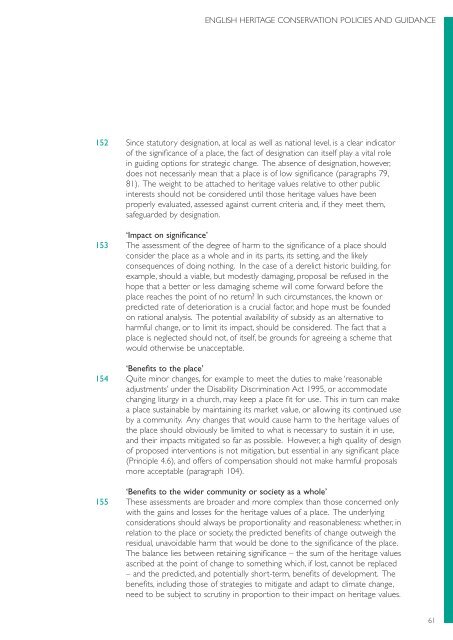Conservation Principles, Policies and Guidance - English Heritage
Conservation Principles, Policies and Guidance - English Heritage
Conservation Principles, Policies and Guidance - English Heritage
You also want an ePaper? Increase the reach of your titles
YUMPU automatically turns print PDFs into web optimized ePapers that Google loves.
ENGLISH HERITAGE CONSERVATION POLICIES AND GUIDANCE<br />
152 Since statutory designation, at local as well as national level, is a clear indicator<br />
of the significance of a place, the fact of designation can itself play a vital role<br />
in guiding options for strategic change. The absence of designation, however,<br />
does not necessarily mean that a place is of low significance (paragraphs 79,<br />
81). The weight to be attached to heritage values relative to other public<br />
interests should not be considered until those heritage values have been<br />
properly evaluated, assessed against current criteria <strong>and</strong>, if they meet them,<br />
safeguarded by designation.<br />
‘Impact on significance’<br />
153 The assessment of the degree of harm to the significance of a place should<br />
consider the place as a whole <strong>and</strong> in its parts, its setting, <strong>and</strong> the likely<br />
consequences of doing nothing. In the case of a derelict historic building, for<br />
example, should a viable, but modestly damaging, proposal be refused in the<br />
hope that a better or less damaging scheme will come forward before the<br />
place reaches the point of no return? In such circumstances, the known or<br />
predicted rate of deterioration is a crucial factor, <strong>and</strong> hope must be founded<br />
on rational analysis. The potential availability of subsidy as an alternative to<br />
harmful change, or to limit its impact, should be considered. The fact that a<br />
place is neglected should not, of itself, be grounds for agreeing a scheme that<br />
would otherwise be unacceptable.<br />
‘Benefits to the place’<br />
154 Quite minor changes, for example to meet the duties to make ‘reasonable<br />
adjustments’ under the Disability Discrimination Act 1995, or accommodate<br />
changing liturgy in a church, may keep a place fit for use. This in turn can make<br />
a place sustainable by maintaining its market value, or allowing its continued use<br />
by a community. Any changes that would cause harm to the heritage values of<br />
the place should obviously be limited to what is necessary to sustain it in use,<br />
<strong>and</strong> their impacts mitigated so far as possible. However, a high quality of design<br />
of proposed interventions is not mitigation, but essential in any significant place<br />
(Principle 4.6), <strong>and</strong> offers of compensation should not make harmful proposals<br />
more acceptable (paragraph 104).<br />
‘Benefits to the wider community or society as a whole’<br />
155 These assessments are broader <strong>and</strong> more complex than those concerned only<br />
with the gains <strong>and</strong> losses for the heritage values of a place. The underlying<br />
considerations should always be proportionality <strong>and</strong> reasonableness: whether, in<br />
relation to the place or society, the predicted benefits of change outweigh the<br />
residual, unavoidable harm that would be done to the significance of the place.<br />
The balance lies between retaining significance – the sum of the heritage values<br />
ascribed at the point of change to something which, if lost, cannot be replaced<br />
– <strong>and</strong> the predicted, <strong>and</strong> potentially short-term, benefits of development. The<br />
benefits, including those of strategies to mitigate <strong>and</strong> adapt to climate change,<br />
need to be subject to scrutiny in proportion to their impact on heritage values.<br />
61

















